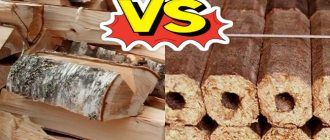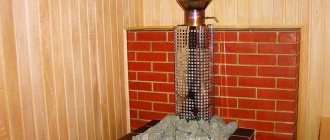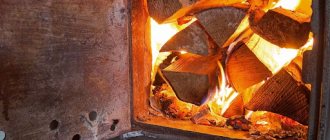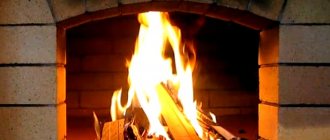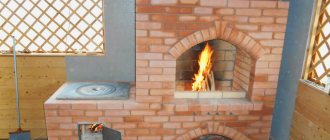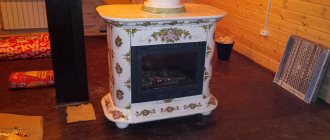Despite the fact that there is a wide choice of heating systems, many homes still have wood stoves and fireplaces. And even if gas heating appears, the owners of the house do not part with their favorite stove.
There is something primitively attractive in these living flames, the crackling of firewood, in the special atmosphere of warmth and smell emanating from the stove. And even its difficult maintenance, preparation of firewood and kindling are justified by this. In order to get high-quality heat and a pleasant specific aroma, you need to choose the right firewood.
What quality firewood should be?
Different types of wood differ in quality characteristics. Before purchasing such fuel, you should figure out what kind of wood to heat the stove with. Some wood is used to build houses, the other is used for heating. Moreover, such fuel is also selected for different heating devices. Wood with a good aroma, but not resinous, is suitable for the fireplace. With a high resin content, firewood produces a lot of smoke and can scatter sparks and embers around, which is a fire hazard. It is highly undesirable to use pine logs for open fireplaces.
For heating stoves, choose fuel that can burn for a long time and has high efficiency. They also look at how much ash remains after the woodpile burns and how much smoke there is. In other words, good firewood should heat the room efficiently, not create smoke, and burn as much as possible.
To choose the best firewood for heating stoves, it is not enough to buy good wood, you also need to dry it properly and store it in a suitable place. Freshly cut wood will not be used for firewood, because it will burn poorly due to the large amount of moisture. First, the wood must be dried. When the moment comes that when the logs hit one another there is a loud knock, it means they are ready for firing.
It is best to collect firewood in winter, when sap flow is minimal. In spring or summer, it is better not to prepare firewood; the wood will take a very long time to dry out.
The best firewood for stoves comes from hardwood trees with dense fibers. They burn for a long time and have high heat transfer. Deciduous firewood includes oak, linden, alder, birch, and ash firewood.
The question often arises: is it possible to heat a stove with spruce wood? Yes, theoretically it is possible, logs obtained from coniferous trees burn well. But they smoke very strongly and burn quickly, and their heat transfer is not high.
Folk tales
Superstitions and beliefs circulate among the people. For example, it is believed that it is better to prepare firewood for a bath during the waning moon. Moreover, the thinner the sickle, the stronger the logs are endowed with healing powers. Once upon a time, the Slavs believed that people who left the world turned into maples in their lives. The appearance of its leaves is akin to open palms, and its branches represent hands raised to the heavens. For this reason, they never fired maple stoves.
In the old days, residents of the Tambov province heated their stoves exclusively with apple trees to keep the house warm throughout the winter, including especially frosty days. Whether to believe all this or not is everyone’s business, but what happened was what happened. What do you, dear readers, think: what kind of firewood is better for a stove, bathhouse or fireplace?
Hardwood firewood for heating the stove
Deciduous trees are considered one of the best for use as firewood, but each tree of this type has its own thermal characteristics.
- Oak firewood. They have a solid structure, a long burning period, and excellent heat transfer. We can say that oak, due to its properties, is one of the most suitable for preparing firewood. Despite the fact that oak is quite expensive to purchase, it is economical and consumes more slowly than other firewood. The price is quite consistent with the thermal characteristics.
- Middle-aged oak trees are excellent for stoves; it is this wood that has optimal properties. Young oak trees have a small amount of heat, and they also fill the air with the smell of coal. If you burn with old oak, the amount of ash will increase significantly and the air will be heavy from it.
- During combustion, oak wood emits hot fire and tart forest smoke. When the fireplace is heated with oak logs, a healing atmosphere is created in the room. The healing qualities of oak logs have already been proven. Original Italian pizza is prepared only on oak wood. Moreover, in Italy it is difficult to find oak logs; they are “worth their weight in gold” there.
- Birch logs. They have special valuable qualities that people have known about since ancient times. Birch firewood is especially suitable for heating sauna stoves. With the help of birch heat, you can disinfect rooms; a wonderful aroma emanates from birch. Such firewood burns for a long time and produces a high, even flame; the fire does not spark. If you take a steam bath heated with birch firewood, colds and many chronic respiratory diseases will go away. However, here we must take into account such a property of birch as the loss of its valuable medicinal qualities just a couple of years after the birch is cut down for firewood. The fact is that birch logs become outdated quite quickly. When the log becomes rotten, such a hot fire will no longer be possible. Birch bark and the wood itself contain a lot of tar. It is a carbon compound due to which birch quickly ignites and burns intensely. This property is used to make splinters for lighting “heavy” wood. Birch has a heat transfer coefficient that is about a quarter higher than that of aspen or pine. However, the fact that birch leaves a lot of soot hinders the constant use of birch logs. Chimneys will have to be cleaned much more often.
- Alder logs. The structure of alder wood is very beautiful in color. It can be ocher, orange, bluish or even bright red. There are more than 25 species of alder, and each has its own shade of color. Alder logs can be stored for a long time, that is, they can be stored for future use for several years to come. For harvesting, as a rule, they choose places in forest areas where humidity is low, away from rivers or lakes, which is where the wood is more suitable for kindling. Alder also has a fragrant smoke that can be heard for about three years after the tree is harvested. Alder retains all other properties much longer. When burning, the heat transfer is very high, the logs almost do not smoke. In the old days, alder was used to heat a black bathhouse. On a note. When burning alder logs, the chimney ducts of the stove are cleared of soot. It is good to use alder firewood for a smokehouse; you get very tasty smoked meats. Therefore, when preparing firewood, there is no need to throw away sawdust; they will come in handy. Alder should be harvested in winter, since it is impossible to get close to it in summer - it loves swampy places.
- Linden logs. They are valued for their intense combustion and quick heating of the stove. However, it is difficult to light a linden tree; many people know this feature. Linden has the same healing properties as birch; they are successfully used to kindle baths. Once upon a time, several grams of honey were added to linden firewood and this was how they treated lung diseases and old wounds that did not heal for a long time. Linden has strong healing properties, but they last no more than two years after cutting. And this is considered the only drawback of linden logs.
- Aspen firewood can clean a chimney without a chimney sweep, just like alder firewood. Aspen produces almost no soot or smoke. Evaporation from the combustion of aspen loosens soot deposits on the walls of the chimney pipe, causing it to crumble into the ash compartment of the stoves. And yet, is it possible to heat a stove only with aspen? Yes, you can: you won’t get good heat from aspen, but a cleaned chimney increases the efficiency of the stove. Therefore, aspen logs are used for preventive purposes to clear soot from chimney ducts and to melt logs with a dense structure.
- Logs made from poplar and willow wood. You can use them for heating, but they burn out quickly. Therefore, an affordable price does not allow you to save in the end. To warm a room with willow and poplar logs, you need to take a large amount of them. Therefore, this type of wood is used only if there is no other choice. Low-grade wood can be purchased only when it is impossible to buy firewood with good thermal performance.
Characteristics of firewood
It is not always appropriate to compare heating a house with a stove and electricity or gas, since the stove additionally creates an atmosphere of comfort and unique family coziness. How pleasant it is to hear the soft crackling of firewood in the hearth in the silence of the doom, to feel the warmth emanating from it. Even in our time, these unique feelings are so pleasant to people that a high-quality stove or a good fireplace is built in almost every private home.
However, in order to effectively use the capabilities of the stove, you should understand firewood. It turns out that not all tree species are equally good for burning; there are many nuances that significantly complicate the choice of firewood for the stove.
For example, for burning in a fireplace, it is advisable to find wood that, when burned, emits a pleasant aroma, but does not emit a large amount of resin, soot, or soot. Resins in wood contribute to increased smoke output, as well as explosive cracking of logs with the release of large coals. Such emissions will be unsafe for an open fireplace, so coniferous wood is not used in them.
Firewood for the stove is selected based on heat transfer; its main criteria are the intensity and duration of combustion. It is desirable that the wood burns with less smoke and leaves behind a minimum of ash.
Wood for making fire
If we consider the optimal firewood for use in a stove, then it should have the following functionality:
- First of all, heat transfer is the maximum possible for wood.
- The flammability of the wood must also be excellent, so that lighting a fireplace is not difficult.
- When burned, firewood should not emit a lot of smoke and leave behind a small amount of ash.
To achieve such characteristics, it is important not only to choose the right type of wood, but also to properly dry the harvested timber and ensure its normal storage. Freshly cut wood is not used in kilns; to prepare it, it should be dried for some time, getting rid of excess moisture. Wet wood burns weakly and produces a large amount of smoke.
There is even a method for determining whether firewood is dry enough for use in fireplaces or stoves. You should hit one log against another and listen to the sound. If it is sonorous, then it is quite possible to use such logs for heating the hearth.
It is believed that the best firewood for fireplaces and stoves is obtained if logging is carried out in the winter. At this time, the trees are in a certain preserved state, as a result of which sap flow practically does not work in them. The worst thing is if the firewood is collected in the spring or summer, when the wood contains a large amount of moisture, such wood will dry out for a very long time.
Firewood harvested in winter can be split in summer
If we consider tree species, then it is best to choose deciduous options, since they have a fairly dense fiber structure. Such wood is capable of generating large amounts of heat for a long time. Most often, firewood is prepared from the following hardwoods: oak, birch, linden, alder, ash, aspen. Even fruit trees can be a good source of heat. In addition, the fragrant wood is perfect for use in a smokehouse or open fireplace.
Good to know: Firewood holders for fireplaces and stoves, solutions for storing firewood at home
Coniferous wood also burns well, but since they contain a large amount of resin, they emit a lot of smoke and soot when burning. The needles burn quite quickly, but produce mediocre heat, so for use in a stove at home it is better not to particularly consider this option, but to save the logs for the bath.
Logs from fruit trees
Fruit trees also have good properties needed for a hearth. They are used both for stoves and for barbecues and smokehouses. Fruit wood has a very good aroma.
When cutting down fruit trees, it is advisable to store this wood and then use it to light the stove. It will also be used for barbecue and smokehouse. Most often, this wood can be purchased by cutting down old orchards. The most common trees for kindling are cherry or apple. Cherry logs emit more soot, but light up very well. Apple logs do not produce much smoke, therefore they are considered the highest quality fuel.
Medicinal properties are attributed to many fruit trees, for example, apple and pear trees of certain ages.
Softwood firewood
Coniferous trees contain resinous substances in excess and produce a lot of smoke, which severely clogs the chimney. These logs burn very quickly. It is better not to use coniferous wood for the stove. Stoves and fireplaces should be heated with softwood logs very carefully. But even with its shortcomings, such firewood is popular.
Sometimes pine needles are used to heat baths to fill the steam room with oils from coniferous trees. The healing powers of pine and spruce help to cure diseases of the respiratory system and calm the nervous system.
On a note. Sometimes you can see how home owners use the firebox to dispose of unnecessary paper and other garbage; thick black smoke comes out of the chimney. In addition to the fact that this leads to environmental degradation, you should know that the chimney ducts become clogged, becoming covered with a thick layer of soot.
How to store firewood
After purchasing firewood, you need to put it in a place where it can retain its properties for a long time. The place is prepared in advance. You can simply stack the firewood under the shed as best you can. But if you approach the process creatively, then you can create a real masterpiece from an ordinary woodpile and decorate your garden plot. To prevent logs from falling apart, they are often stacked, resting on three sides against the walls of buildings. You need to know that firewood will provide good heat transfer only if it is stored correctly.
You should find the right place to store logs, and you need to follow certain rules when storing firewood:
- The woodpile should be located not far from the exit of the house, so that in winter it is convenient to go there for the next portion of fuel in any weather.
- You need to saw and chop firewood not in winter, but in advance, before the onset of frost.
- For firewood to burn well, it needs to be well dried. This state is then maintained by specially arranging the woodpile.
- You cannot store firewood in low areas where there is a high level of humidity. The firewood will become damp again and may even rot. You will not get pleasant aromas and good heat from such firewood.
- A canopy is installed on top of the woodpile, or it is laid in such a way that no precipitation gets into the woodpile through the top row. Moreover, they must be well ventilated, for this they maintain a certain distance.
To make the woodpile stable, you can lay it in a bandage.
On a note. Wood cut down in winter is stored in a woodpile after 4-6 months. Spring and summer preparations are dried longer, 8-12 months. It depends on the weather, humidity level, and the place where the firewood is dried.
This is important to know!
Regardless of the type of trees that will be used for firewood, you need to know about some features:
- Deadlines. Of course, those logs that have already served their “allotted” time will also burn (provided that they are dry and there is no mold on them). However, most trees retain their aroma only for two years. Alder and aspen are a pleasant exception in this regard - 3 years.
- Everything has its time. In winter, the humidity of trees is at a minimum level. In this regard, the preparation of firewood must be done during this period. Drying usually takes about 12 months. However, the timing depends on the type of forest, harvesting time, storage conditions and a number of other factors. In this case, the duration may increase significantly or, conversely, decrease.
- Dimensions. Which firewood is more profitable? Of course, those with optimal sizes. And these are 40-50 cm in length and 8-10 cm in thickness. This is how they are convenient to store and are suitable for any firebox.
- Rot. Under no circumstances should you use rotten firewood. Keeping logs on the ground for a long time results in the accumulation of toxic substances released during combustion, which is not beneficial to humans. For this reason, when cutting down branches, you should immediately take the correct measures to store them. When choosing raw materials for heating among dead wood, you should not take into account long-fallen branches.
- Storage issues. Logs should be laid with the bark facing up. This will protect the firewood from accidentally entering moisture, which evaporates faster from the surface of the bark. And if you show your imagination, you can build an original woodpile to the delight and surprise of your guests.
As can be seen from this material, it is not enough to know which firewood is best for the stove. It is equally important to ensure that they are stored correctly.
Regarding the arrangement of a woodpile, you can always come up with a lot of different ideas: from the most creative and crazy to the simplest to implement.
How logs are stored
To ensure reliable storage of firewood, it must be stored correctly. The future warmth in the house depends on this. The storage area is protected from rain and snow falling on the woodpile. Fuel preparations do not need direct sunlight.
After the logs are sawed and chopped, they are left for some time in bulk in a place that is well ventilated and where the sun penetrates.
If the wood was harvested in winter, the cutting is done in the spring, so that there is time for drying and ventilation in the summer. But logs should be placed in the woodshed only at the end of summer or with the onset of autumn. When a separate shed is not provided for firewood, a base is made for the woodpile from trellises - pipes or even tree trunks of medium thickness.
The first row of logs is folded so that their ends rest on the trellises and are slightly raised above the ground. Each next row is laid at a slight angle to the previous row. You will also need vertical supports to strengthen the woodpile.
The outermost vertical rows of logs are folded alternately lengthwise and crosswise.
If there is no canopy, you need to build any shelter from the sun and rain. It can be sheet iron or slate. Sometimes they use good quality cellophane film that will withstand wind and temperature changes.
A very convenient way to store firewood for a long time is to install a woodpile in stacks.
What types of woodpiles are there?
There are various forms of stacking logs. You can choose the one that is suitable in this particular case.
Woodpiles can look like this:
- In the form of “sheaves”. It is very convenient to store in this form, since you do not need to build a shed or shed for this. In order to lay out a woodpile in a “stack”, you need to find wood of suitable quality that can be stored for a long time and learn how to stack the logs correctly. Such “sheaves” will last for several years and the firewood will retain its properties. Trellis are placed at the base of such a woodpile. You can lay flat stones or bricks as the base. The main thing is to raise the logs above the ground so that they do not get damp. The base is laid out in a circle, the logs inside are placed in random order. This idea is to ensure that the firewood is well ventilated. A pole is installed in the middle, which will hold the entire structure, from bottom to top.
- This styling looks very aesthetically pleasing. If you put wood of different species in such a “sheaf”, the multi-colored structure will decorate any landscape.
- The second way is in the form of a “fungus”. The stacking method is similar to a “stack”; the logs are split in a special way - not in logs, but in short planks. With the help of such a flat shape, the installation of such a “fungus” is easier. If you want to make the “mushroom” symmetrical in shape, you need experience and time. But this option will be a wonderful decoration for your garden plot.
- The woodshed is compact in size with an original roof. Most often, woodpile designs are made simple, without thinking about the aesthetic appearance. And completely in vain. Woodsheds can not only diversify the landscape, but also divide the area into zones. Compact structures are installed in cases where firewood is used from time to time, not as the main fuel.
- Large woodsheds are storage facilities in which you can store a large number of logs, stocking up for several winters ahead. Externally, such warehouses resemble gazebos, there are cracks in the walls for ventilation of the wood, the roof is reliable and should cover the entire woodpile.
- You can put a woodpile right next to the house. A roof of this design protects the path between the building and the woodpile, that is, snow will not get there. Therefore, getting to the firewood in winter will be easy. The firewood is well ventilated and protected from the sun and precipitation. If you stack the logs in this way, you don’t have to worry about them getting damp or rotting. The construction of such a structure is not difficult. You will need to stock up on wooden blocks or metal corners, a chain-link mesh with large cells, and any roofing material. Floors should be laid with simple tiles, such as those used for sidewalks.
On a note. For good, quick lighting of the stove, firewood is brought into the room in advance so that it can dry in room conditions. For this purpose, special structures are installed near the stove or fireplace, where 1-2 stacks of firewood are placed. This rack is filled as needed.
Basic storage rules
To get a high-quality product for lighting a hearth or fireplace, you need to cut down a tree in an ecologically clean area, where there are no exhaust gases or chemical production. There should be no delay in separating the trunk and crown in parts
It is important to dry the logs outdoors with good ventilation under a canopy.
The next stage is splitting into smaller elements. This way the logs dry faster and are easier to store. It is logical that the thinner the firewood, the faster it will dry. Therefore, it is better not to store them in the form of thick logs, but to chop them in the form of thin logs. You will also need brushwood—thin branches—for ignition. Rows are laid in several ways:
- Each next row of blanks is located perpendicular to the previous one. There must also be clearance inside the row;
- All logs are stacked in one direction, maintaining a gap between each piece;
- Laying in a circle. This method is called a “stack”, it involves stacking firewood in one direction. Under no circumstances should brushwood and logs be stacked tightly: circulation will be disrupted and they will begin to rot.
The woodpile is placed in a well-ventilated space, under a canopy or dense material. The canopy must have supporting pillars without walls to restrict air movement.
The woodshed must be covered with a roof to protect the wood from ultraviolet rays and precipitation.
It is not recommended to store firewood in a shed. Lack of sunlight will lead to moisture accumulation, fungus will form, and the woodpile will begin to rot. Also, precipitation should not be allowed to enter.
Before putting it into the stove or fireplace, the firewood must be kept in the living room for at least 24 hours. They are placed next to the stove, but not very close to the firebox (keeping fire safety in mind). For this purpose, a special niche is provided or decorative floor firewood holders are used.
The best wood for kindling is dry. Therefore, you should carefully consider its preparation and storage. Whatever type of firewood is chosen for the stove, the most important thing is not to forget about the features and differences in the properties of deciduous, coniferous and fruit logs.
Results
The quality of heating the room directly depends on how correctly the firewood is stacked, how it is stored, and when it is harvested.
You need to know what kind of wood is best to burn the stove with. The heat transfer of different tree species is different, you need to remember this.
When choosing firewood, you need to know the degree of its ash content. The more waste remains from the logs, the lower the efficiency. And this is not economical. A lot of smoke is not a sign that the firewood provides good heat transfer. The only thing that can be said for sure about such firewood is that they clog the smoke exhaust channels.
Oak logs have the highest efficiency; linden and birch have especially healing properties. Willow and poplar are taken as a last resort. Coniferous trees clog chimneys. If you need to clean chimney ducts, aspen and alder will help.
An aesthetically pleasing woodpile will give an ordinary garden plot a creative look. You need to stack the woodpile slowly and carefully, ensuring the stability of the structure, good ventilation of the wood and a neat appearance.

